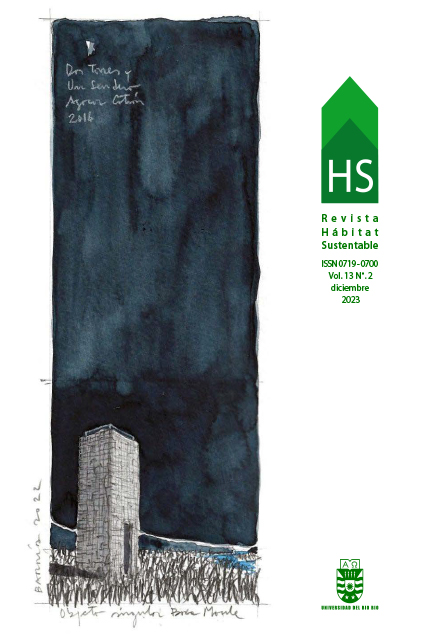Manufacture of lightened mortars with perlite and lime applied in panels with a rice straw residue mix
DOI:
https://doi.org/10.22320/07190700.2023.13.02.06Keywords:
plaster, mortar, strawAbstract
This research aims to design and characterize plaster mortars based on perlite and lime produced in Ecuador, with a minimum compressive strength of 6.89 MPa, as established by IRC 2018, to be applied on rice straw panels. For this purpose, two standard mixes are designed. In the first, sand is used as fine aggregate, while in the second, perlite is used. Eight additional mixes are obtained from each one, where cement is replaced by lime (in volume) in different percentages. A total of 270 test specimens were made to evaluate the compressive strength and density of the mortars at 1, 3, 7, 28, and 50 days. The mortar made with perlite, comprising 50% lime, 50% cement, and an additive, reached a resistance of 7.22 MPa, with a density of 1.45 g/cm³. When this mixture was applied to the rice straw panels, it resulted in an increase of up to 68% in their compressive strength.
Downloads
References
APOSTOLOPOULOU, M., BAKOLAS, A. & KOTSAINAS, M. (2021). Mechanical and physical performance of natural hydraulic lime mortars. Construction and Building Materials, 290(1), 1-14. https://doi.org/10.1016/j.conbuildmat.2021.123272
APRIANTI, A. (2017). A huge number of artificial waste material can be supplementary cementitious material (SCM) for concrete production e a review part II. Journal of Cleaner Production, 142, 4178-4194. https://doi.org/10.1016/j.jclepro.2015.12.115
ARTIGAS, V., QUINTANA, M., POSITIERI, M. & OSHIRO. A. (2022). Efectos de la utilización de desecho polvo de perlita natural en hormigones autocompactantes coloreados. Concreto & Construções, XLIX(105), 42-47. http://dx.doi.org/10.4322/1809-7197.2022.105.0003
CASCONE, S., RAPISARDA, R. & CASCONE, D. (2019). Physical Properties of Straw bales as a construction material. Sustainability, 11(12), 1-19. https://doi.org/10. 3390/su11123388
ECHEVERRÍA, M., FLORES, V. & DEL RÍO, J. (2022). Reuse of banana fiber and peanut shells for the design of new prefabricated products for buildings. Revista de la Construcción, 21(2), 462-472. https://doi.org/10.7764/RDLC.21.2.461
El MIR, A., NEHME, S. & ASSAAD, J. (2020). Durability of self-consolidating concrete containing natural waste, Heliyon, 6(1), 1-10. https://doi.org/10.1016/j.heliyon.2020. e03165
ESBA. (2021, December 22). UP STRAW: Interreg Project | ESBA. https://strawbuilding.eu/up-straw-interreg-project/
FERNANDEZ, F., GERMINARIO, S., BASILE, R. & MONTAGNO R. (2020). Development in construction Industry Development of Eco-Friendly and Self-Cleaning Lime-Pozzolan Plasters for Bio-Construction and Cultural Heritage. Buildings, 10(10), 172, 1-12. https://doi.org/10.3390/buildings10100172
HERMIDA, Á. (2021, February 15). Cemento y crisis climática: cómo el material supremo calienta el planeta. elconfidencial.com. https://www.elconfidencial.com/medioambiente/ciudad/2021-02-15/cemento-gases-efecto-invernadero-calentamiento_2944723/
INTERNATIONAL CODE COUNCIL (ICC). (2018). 2018 INTERNATIONAL RESIDENTIAL CODE (IRC)|ICC DIGITAL CODES. https://codes.iccsafe.org/content/IRC2018/appendix-s-strawbale-construction
MARTÍNEZ S., C. (2021). Estudio y aplicaciones de las construcciones con fardos de paja [Trabajo final de Grado]. Universidad de Valladolid. https://uvadoc.uva.es/bitstream/handle/10324/38967/TFG-A-170.pdf?sequence=1&isAllowed=y
MENDOZA, J. & VANGA, M. (2021). Realidad y expectativa sobre la construcción sostenible en Ecuador. Revista San Gregorio, 1(43), 197-209. https://revista.sangregorio.edu.ec/index.php/REVISTASANGREGORIO/article/view/1116/14-JHON22
MINISTERIO DE AGRICULTURA Y GANADERÍA DE ECUADOR. (2022). Sistema de información pública agropecuaria [SIPA]. sipa.agricultura.gob.ec. http://sipa.agricultura.gob.ec/
MUNTANI, G., AZZOLUNO, C., MACRÍ, M. & MANCUSO, S. (2020). Straw Buildings: A Good Compromise between Environmental Sustainability and Energy-Economic Savings. Applied Sciences, 10(8), 1-19. https://doi.org/10.3390/app10082858
PAHLAVAN, P., MANZI, S., SANSONETTI, A. & CHIARA, M. (2018). Valorization of organic additions in restorative lime mortars: Spent cooking oil and albumen. Construction and Building Materials, 181, 650-658. https://doi.org/10.1016/j.conbuildmat.2018. 06.089.
PAVÍA, S., & BRENNAN, O. (2018). Portland Cement-Lime Mortars for Conservation. In J. Hughes, J. Válek, & C. J. W. P. Groot (Eds.), Historic Mortars: Advances in Research and Practical Conservation (pp. 129–142). Springer. https://doi.org/10.1007/978-3-319-91606-4_10
STEPHAN, A. & ATHANASSIADIS, A. (2018). Towards a more circular construction sector: Estimating and spatialising current and future non-structural material replacement flows to maintain urban building stocks. Resources, Conservation and Recycling, 129, 248-262. https://doi.org/10.1016/j.resconrec.2017.09.022
SUDHARSAN, N. & SIVALINGAM, K. (2019). Potential Utilization of Waste Material for Sustainable Development in construction Industry. International Journal of Recent Technology and Engineering, 8(3), 3435-2438. https://doi.org/10.35940/ijrte.c5062.098319
TESLÍK, J. (2021). Analysis of the fire properties of blown insulation from crushed straw in the buildings. Materials, 14(15), 1-12. https://doi.org/10.3390/ma14154336.
VIERA, P. & ACERO, M. (2022). Diseño de un mortero a partir de la caracterización de cal producida y comercializada por 5 proveedores en Ecuador, Novasinergia, 5 (2), 158-173, https://doi.org/10.37135/ns.01.10.09
WALKER, P., THOMSON, A., & MASKELL, D. (2020). Straw bale construction. In K. A. Harries & B. Sharma (Eds.), Nonconventional and vernacular construction materials: Characterisation, Properties and Applications. (2nd Edition, pp. 189–216). Woodhead Publishing. https://doi.org/10.1016/b978-0-08-102704-2.00009-3
YIN, X., LAWRENCE, M. & MASKELL, D. (2018). Straw bale construction in northern China – Analysis of existing practices and recommendations for future development. Journal of Building Engineering, 18, 408-417. https://doi.org/10.1016/j.jobe.2018.04.009
ZHANG, D., ZHAO, J., WANG, D., XU, C., ZHAI, M. & MA, X. (2018). Comparative study on the properties of three hydraulic lime mortar systems: Natural hydraulic lime mortar, cement-aerial lime-based mortar and slag-aerial lime-based mortar. Construction and Building Materials, 186, 42-52. https://doi.org/10.1016/j.conbuildmat.2018.07.053
Downloads
Published
How to Cite
Issue
Section
License
Copyright (c) 2023 Henry Ramos-Rodriguez, Paulina Viera-Arroba

This work is licensed under a Creative Commons Attribution-ShareAlike 4.0 International License.
The content of articles which are published in each edition of Habitat Sustentable, is the exclusive responsibility of the author(s) and does not necessarily represent the thinking or compromise the opinion of University of the Bio-Bio.
The author(s) conserve their copyright and guarantee to the journal, the right of first publication of their work. This will simultaneously be subject to the Creative Commons Recognition License CC BY-SA, which allows others to share-copy, transform or create new materials from this work for non-commercial purposes, as long as they recognize authorship and the first publication in this journal, and its new creations are under a license with the same terms.











 Scientific Information Program/Concurso Fondos de Publicación de Revistas Científicas 2018/ Proyecto Mejoramiento de Visibilidad de Revistas UBB (Código:FP180007).
Scientific Information Program/Concurso Fondos de Publicación de Revistas Científicas 2018/ Proyecto Mejoramiento de Visibilidad de Revistas UBB (Código:FP180007).





